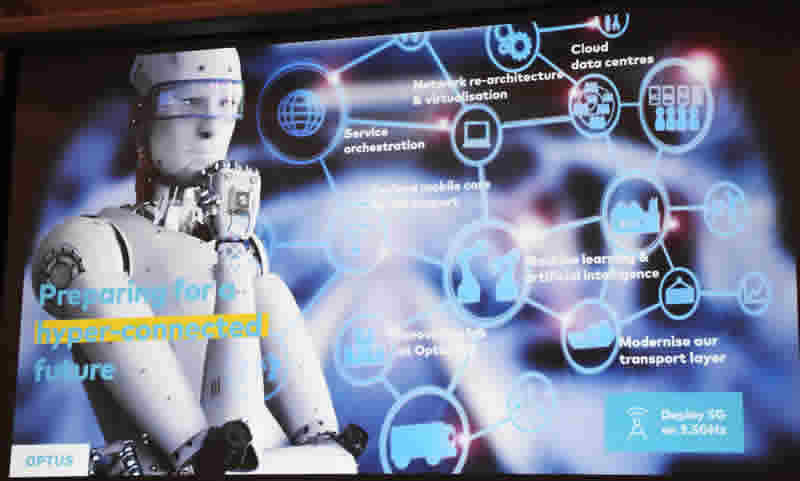Monthly Main Meeting Highlights
The May 2019 Main Meeting
This month Optus

called in to tell us about their new 5G network.

Lambo Kanagaratnam the VP of Network Employment and Karen came along with the full details of how the new Optus 5G network will work. 5G is a full broadband wireless network.

The new Optus 5G Home is a wireless access network run though a CPE or Customer Premises Equipment and delivering a minimum 50MB/s speed for $70 a month.

In January Optus went live with a its first 5G Home Network site in Canberra.
According to the press release of this test.
it achieved “peak download speed achieved at our launch in the ACT in January demonstrated download speeds of 170MBps” The first commercial site in Glendenning north west of Blacktown, showed speeds of “295MBps and an average download speed of 100MBps.”
Optus sees their 5G network as an alternative, as Lambo said “to other broadband products” available. Optus Home has been designed with the fact in mind that most homes have multiply connected devices with a demand for speed over all of the connections. The other “pain points” Lambo spoke to with broadband connection was having to deal with different parties for various parts of the connection process; appointments to install boxes, then others to setup modems.

Optus Home is a plug and play setup, take home your CPE or Customer Premises Equipment, plug it in and sign on. The CPE or Home Hub is a FastMile router by Nokia.
On testing in private homes in the Glendenning test area, Optus found compared to ADSL the Nokia delivered speeds of 6 to 7 times faster than the average NBN speeds.
Lambo moved on to tell us about the CPE. It has 6 antennae’s so that regardless of where it is placed it can pickup the best 5G signal. The antennas are high gain and can pick up between 8 and 11 dBi.
We had a brief look at where all this came from starting with 3G with its 380Kb/s capability. With 4G we saw speeds of 10MB/s to start and now it’s up to 1GB/s. 5G is 40 times faster than 4G to start and will only increase. That speed will allow the 5G network to expand into many other service areas.

For Optus that means a rethink of how the network is used. Lambo drew our attention to the idea of Virtualisation or hyper demand, like the need to increasing data centres for the growth in cloud services. 5G brings the need to have a flexible network that can change as demand changes and virtualisation allows Optus to tailor the system according to the use the customers are make of it, so they may see a demand for download services and allocate the space needed but as the demand drops the system can move on to other high demand areas.
Network slicing with system AI is one example of how Optus is developing the 5G network. An example of network slicing Lambo spoke of was at the home level where we may have a device that’s monitoring the room temperature while we have a security monitor on the front gate. The room monitor takes little energy but we need to see the camera on the front gate and in real time maybe open it. Network slicing allows the routing in demand to prioritised need.
All this is dependent on a continuous upgrade of the whole system from the fibre optic cables and high speed microwave wireless that connect towers to upgrading the base stations themselves. By March 2020 Optus plans to have 1200 of the 7000 base station broadcasting 5G. At first Optus is looking at what areas will have high demand, places like Stadiums, transport networks and CBD areas “where people are not at home but want to use their mobiles”. There are currently 23 suburbs in Sydney and the central coast already receiving a 5G signal.

What are the benefits of 5G? That was the question Lambo went on to look at.
The first is the Home wireless broadband system we just looked at. Things can only get better, as the speed and the latency improve, “latency is how long it takes data to travel between its source and destination, measured in milliseconds.”
More services will be added. In the short term with increased high bandwidth, we can expect real improvements in connectivity between devices, e.g. the smart watches connection to your phone and more reliable connections to your cctv cameras. In education we could see real time virtual reality (VR) between an instructor and the student.
As speeds improve over the medium-term Lambo hopes to see greater uptake of health technologies such as remote health monitoring. This would be a real benefit in remote areas especially if it is backed by VR with a remote doctor having real-time visual information.
Long term, the possibilities for automation Lambo spoke about are huge. Driverless cars, robotics and automated factories. In effect it’s about having such a reliable connection that long-distance transmission of data in real time is possible. These developments rely on developers who can see the possibilities available in 5G. Optus’ roll out is only possible with its collaboration with hardware firms like Ericson and Nokia. They also work with local councils and government to improve regulations for these advancing technologies./p>

5G requires a different way to roll out the network. While the mobile networks use towers for 5G, Optus is looking at small cells. In question time we discussed the base station and spectrum. 5G is in the 3.5 GH range the 4G is 2.6GH. As the 5G spectrum is higher the range is shorter. That means a coverage of between 600 to 300 metres dependent on density of objects like buildings and trees etc. The antennas are smaller, around 1.2 meters and the towers could also be smaller. As the 4G network is going to be maintained the tower sizes are not likely to get smaller for some time.
However, as uptake of the 5G network expands and less demand is place on the 3G and 4G networks then that available spectrum becomes available for 5G. The real benefit of 3.5GH is that the higher spectrum means more capacity is available. In effect you can do more, which is why Optus can offer this home network in 5G while on 4G and below we only had simple phone connectivity.
On a question about towers and radiation Lambo spoke about electromagnetic admissions. Optus complies with the World Health Organisation (WHO) standards and other Federal, State and local standards. Every site is tested for radiation and emission coverage to meet all the emission standards. Yes, Optus shares tower sites and their test include the overall emissions of the site. If you are interested there is a public site the RFNSA.
Here’s the emissions for a tower near me.

One other question was about, power outages, limiting phone calls and emergency contacts, the bug bare of the NBN. Do the 5G towers have battery backup? Generally, there is a 4-hour backup time and if needed a technician will install a backup generator.
If you like the idea of an Optus Home network you can check availability here.
It’s unlimited data for $70 a month with a minimum of 50 Mb/s
The Raffle
Optus donated a great prize of a full year’s access to Optus Sport,

Karen told us all about the prize,

Our winner

Our Next Main Meeting is Tuesday the 18th of June 12:30 to 3:30 pm
Please Note its one week earlier then normal and is the first of our three winter day time meetings
See you there.
Go to: Previous Main Meeting's Index
